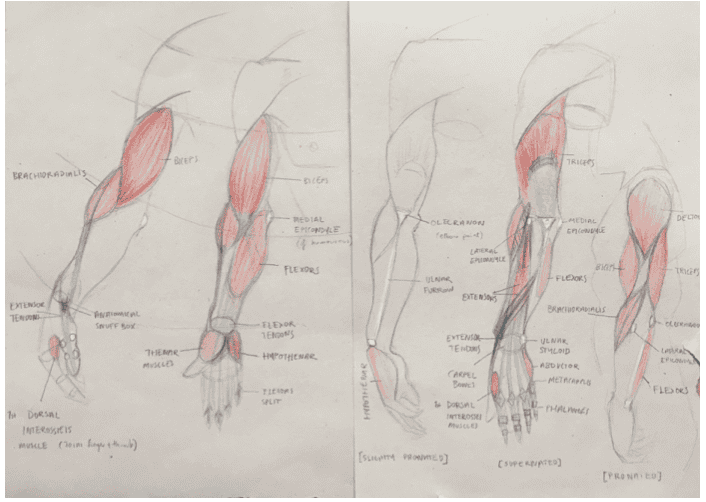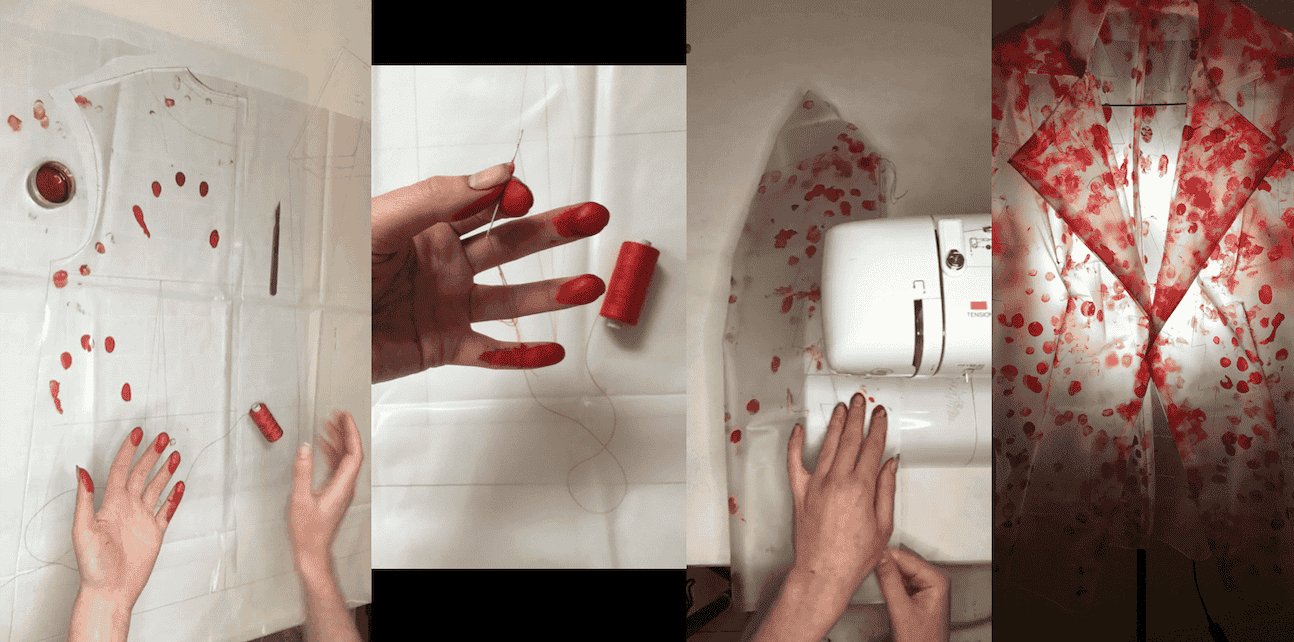13. I M P & A P P _ L I C A T I O N S¶
Implications and applications
P R O J E C T _ P R O P O S A L¶
While I initially pitched the idea of making anatomically inspired pieces for the body to wear and interact with, I also kept an open mind throughout the course.
However, this subject still excites me to beyond and I feel I have something inside me that I need to explore / make / release!
C O N C E P T
Bring the inside out!
A N A T O M I C A L _ C O U T U R E
I wish to make a series of wearable pieces / garments
-
Inspired by the Human Body + Anatomy
-
Incorporate an interactive element
-
Combine traditional techniques with modern advances and technologly
-
Keep in mind 3 key words = Wow! Elegant & Playful (stick with signature + style)
A N A T O M Y¶
Breaking down and defining - What is Anatomy ?
 Dictionary definitions from Oxford Languages & Rembrant’s “The Anatomy Lesson of Dr. Nicolaes Tulp”
Dictionary definitions from Oxford Languages & Rembrant’s “The Anatomy Lesson of Dr. Nicolaes Tulp”
Key Terms
-
Surface Anatomy - The study of anatomical landmarks that can be identified by observing the surface of the body. Sometimes called superficial anatomy.
-
Microscopic Anatomy The study of minute anatomical structures on a microscopic scale, including cells (cytology) and tissues (histology).
-
Gross (or macroscopic) anatomy The study of anatomical features visible to the naked eye, such as internal organs and external features.
-
Embryology The science of the development of an embryo from the fertilization of the ovum to the fetal stage.
-
Dissection The process of disassembling an organism to determine its internal structure and understand the functions and relationships of its components.
Key terms found at Defining Anatomy
I N S P I R A T I O N¶
L I F E _ D R A W I N G¶
Over the years I have become quite obsessed with Life Drawing and subsequently, Anatomy.
I initially started drawing my fashion and costume designs.
I felt the illustrations could have been stronger if I learnt more about life drawing - what is under the clothes ?
Hence, I spent the last few years drawing hundreds of life models (both in person and online).
Then I felt my drawings would be better if I learnt about Anatomy - what is under the skin ?
Now, I would like to combine all of these elements together.
Inspired by my own life drawings & observation of the body both in real life and through images.



P R E V I O U S _ W O R K¶
Personal projects that I have made over the years to try and understand the body. These projects are wearable pieces that are inspired by human anatomy that visually demonstrate some of the anatomical structure.
I want to build on this idea.
These pieces however took a long time to make and I have not yet fully finished them.

_ 1 Initial study of human Torso and dirrection of muscle fibers
__ 2 Corset pattern
___ 3 Hand stitching glass beads in anatomy structure
____ 4 Mapping the placement of the muscles etc to match the wearer
_____ 5 Sewing in boning - think about boning in relation to skeleton ?
______ 6 Piece worn, but not yet finished


_ 1 Corsetted Anatomy from a Medical Larousse (1920)
__ 2 Ludovic O’Followell a medical doctor used X-rays to highlight the damaging effects of tight corsets on woman’s body (1908)


_ 1 Working out the anatomical structure to create one 2D pattern of arm lifesized
__ 2 Hand stitching thread to show anatomy pattern
___ 3 Finalised Glove

Pieces worn

Fingerprint jacket
Concept of showing the many fingerprints that it takes to make a jacket
R E S E A R C H¶
Various books that I have collected recently based on science, anatomy, human figure and movement
_ 1 The Faber Book of Science - edited by John Carey
__ 2 Anatomy: Exploring the Human Body - Phaidon Editors, with an introduction by Thomas Schnalke
___ 3 Atlas of Anatomy - Giovanni Iazzetti, Enrico Rigutti
____ 4 On Architecture - Vitruvius

_____ 5 Morpho: Anatomy for Artists - by Michel Lauricella
______ 6 The Seduction of Curves: The Lines of Beauty That Connect Mathematics, Art, and the Nude - Allan Mcrobie
_ 7 The illustrations from the works of Andreas Vesalius of Brussels - Andreas Vesalius
__ 8 Body Stages: The Metamorphosis of Loïe Fuller

Extract from Going inside the Body chapter in The Faber Book of Science.
Explains the advances in Anatomy by Andreas Vesalius in the sixteenth centuary.
Prior to this, the only knowledge of inside the body was based on animals.
R E F E R E N C E¶

_ 1 Nancy Brooks Brody (2011) - Interested in the geometry of human body + space
__ 2 Lucy McRae & Bart Hess - Intrigued by body modification + exaggeration
___ 3 Else Neuländer-Simon (1933) - Interested in body movement + capturing moments

Monster Club (1981) - Admire the playful + fun concept of a striptease skeleton
Play with the idea of layers - Exposing + Covering
Triadisches Ballet | Triadic Ballet by Oskar Schlemmer
Adore the use of sound, movement & shape and how they interact together / inspire eachother
Spitfire | Matthew Bourne's Christmas
Admire exquisite choreography and multiple dancers bringing to life statuesque classical poses
Further Reference / Inspiration
Augmenting materials with electrical properties
Arts + Reaction Diffusion Models
L I V E _ P R O J E C T¶
I have been living with my life drawings for some time now + completely immersed studying the human body.
Inspired by Oscar’s lecture, I began thinking about how I can live my project in a way to better understand it. I have been studying anatomy myself for some time now, but I think in order to go deeper I thought I could:
-
Deeply observe / study how the body moves, breaking muscles/ ligaments down.
I plan to do this with video, stop motion drawing, physical movement, isolation -
Deeper understand what is under our skin, from skeleton to blood vessels.
I plan to do this by research (old and new) in books, videos -
See dissected bodies in real life

Exploring and observing the movement of some muscles and composition
In order so see in three-dimension what I have been studying / drawing, I went to see Body Worlds exhibition in Amsterdam
This exhibition consists of a large display of dissected bodies preserved through the process of plastination.
Plastination is a process used in anatomy to preserve bodies or body parts, first developed by Gunther von Hagens in 1977.
The water and fat are replaced by certain plastics, yielding specimens that can be touched, do not smell or decay, and even retain most properties of the original sample.

Conclusion / Afterthought
-
Prefer when the bodies are in stretched / dynamic poses
-
Think about display = e.g. layered, sliced, illuminated, expanded view, muscles splayed out, isolated (blood vessels)
-
Hard to imagine the bodies moving: still / frozen it time, the life is dead / unatural about the natural
-
Opens up more possible inspiration = eg. blood vessels / nervous system / new bionic advances
L E A R N I N G¶
I really enjoyed every single week and would like to incorporate various elements into my project.
Over the weeks I have been collecting ideas and left notes for myself on the ‘future’ paragraph of each week.
This contains natural ideas that I would like to try / experiment / realise.
While I am here I want to make ultimate use out of the facilities, knowledge, machinery & equipment as much as I can !
I N C O R P O R A T E _ W E E K S¶
The weeks in which I wish to incorporate in particular =
Digital bodies (2)
Circular Open Source (3)
Biochromes (4)
Computational Couture (7)
Wearables (8)
Soft Robotics (9)
Textile Scaffold (11)
Skin Electronics (12)
These roughly translate into three categories
-
D I G I T A L
-
E L E C T R O N I C S
-
A E S T H E T I C S / S U R F A C E / S U S T A I N A B L E
O U T P U T¶
-
Produce series of garments / wearable pieces (combining craft and technology) inspired by anatomy and movement
-
Interactive - variety of elements e.g. light, colour change, shape, inflation, actuation
-
Collaborate with others in different fields
-
Final piece in the form of a film
Want to bring it to life!
Using movement, light and transformation
How the inside and outside can come together
C O L L A B O R A T I O N¶
I would like to encourage collaboration in the form of
-
Performance - Someone strong and confident to wear the pieces and bring them to live / interactive
-
Video / Photography - Invite another eye into the project to capture the transformative changes and interaction
-
Sound - To bring the video + piece together - refect garments / movements (e.g what would this sound like? )
P U R P O S E¶
The purpose of my project is
-
Make the invisable -> visable : Show how certain things function + moving mechanics of the living body.
Exaggerate + Amplify Motion -
Educational : both for myself and others to get a deeper understanding of our bodies + how they work.
Documentation will also be educational and divided into different categories e.g. Academic Anatomy study, electronics, garment production, digital design, so that people can look further into what interests them (different categories for different audiences). -
Appreciation : of the human body (it is incredible what it does + can do) celebrate the body
-
Observe body in alternative way : perhaps design something that helps the body, changes it in some way?
-
Engage Audience : By producing a visual extravaganza that is interactive, interesting & well made (both traditional and advanced technology)
-
Explore / Experiment : e.g. How muscle fibres could meet and inspire textiles and vice versa
T I M E L I N E¶
Now - Jan 9
- Further define and understand project and parameters
- Observe + study body
- Collect inspiration / references / contextualization
- Start on initial designs and samples
Jan 9 - Feb 29
- Further designs and samples
- Make designs
- Finalise pieces
March 1 - March 27
- Film / photograph pieces
- Edit film / video
- Finalise documentation
M A T E R I A L S + M A C H I N E S¶
Material wise, I will work with reliable fabrics and materials + similar marterials to what I have used over the course.
With this I will also incorporate an array of elctronics - using what we have used in the lab and also expanding further to achieve what I want.
Machines I will plan to use the laser cutter, 3D printers, heat press & sewing machine.
Funtion + Aesthetics both informing eachother.
Experimenting with
-
Movement
-
Materials
-
Techniques
S L I D E _ S H O W